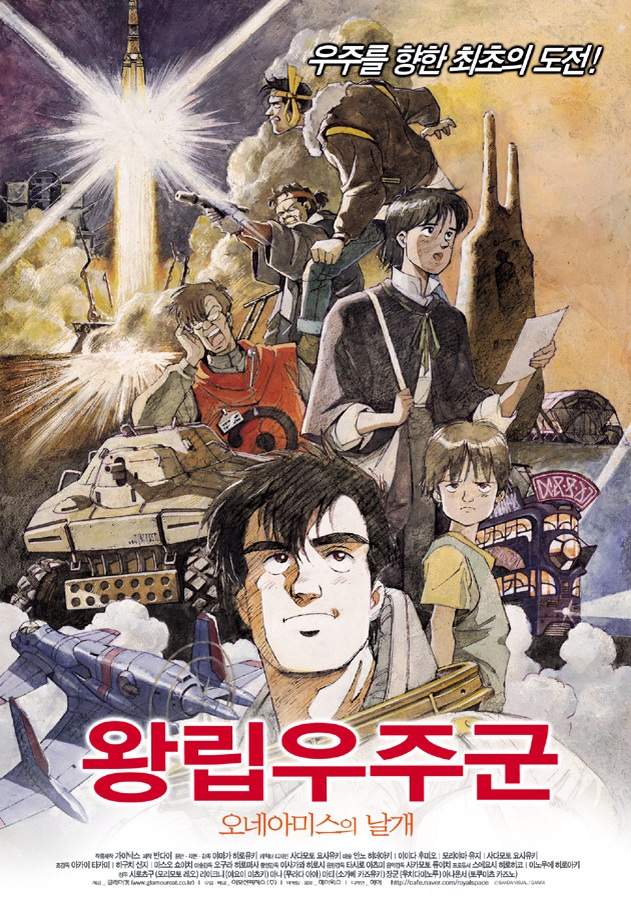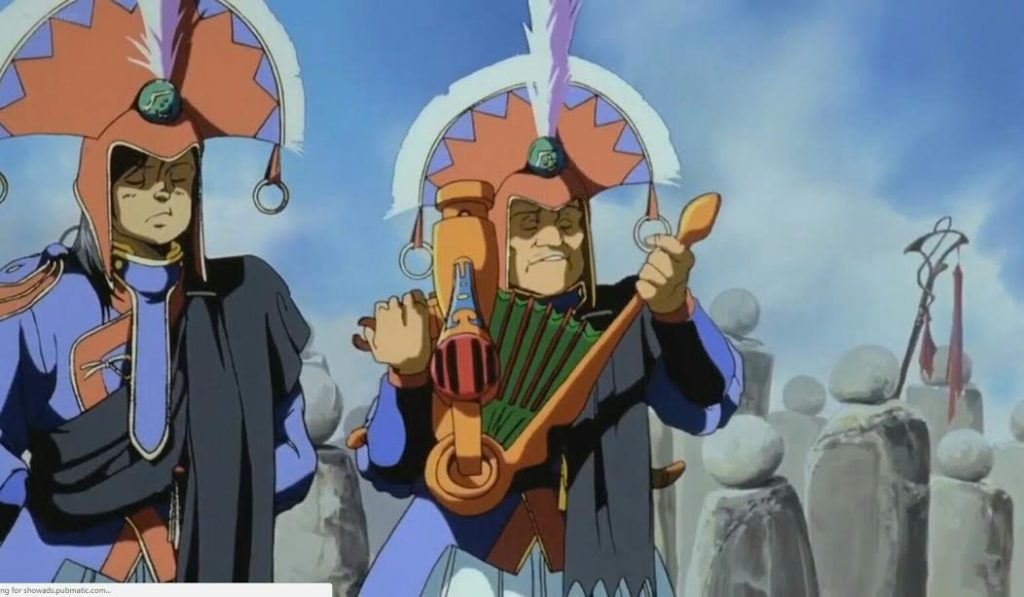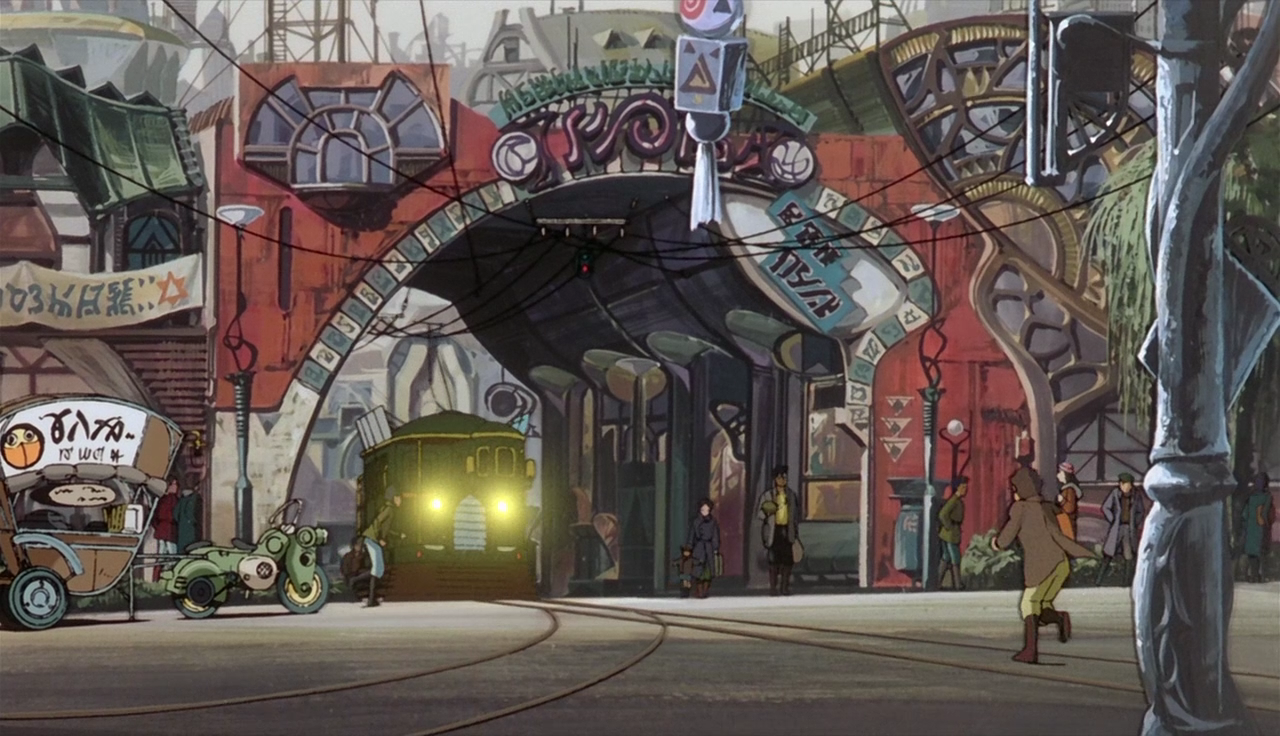Directors: Various
Screenplay: Various
Voice Cast: Various
Viewed in Japanese with English Subtitles
Synopsis: Following the theme of robots, the brightest talents of
Japanese animation in the late eighties create their unique shorts based around
this premise.
Anthologies, in any form, are a
growing pleasure for me in cinema. Even if they have weak or bad segments,
there's usually enough which stand tall and make the project worthy of its
existence. In anime it makes sense to, whether they are financially viable or
sadly not, as when they are brought together, they allow both veterans of anime
alongside new talent to collaborate with creative control, at least in theory,
on interesting results. Sometimes there is a tentative theme to the anime
anthologies, and in some cases with the most successful being The Animatrix (2003), there has been a
great advantage in anthologies based on Western properties. And when a segment from Short Peace (2013) gains an Academy nomination for Best Animated
Short, the existence of anthologies is something that has to be protected,
especially as they are a way to allow creators to have a project when feature
films or TV series are not on their schedule.
Katsuhiro Otomo, the legendary manga author and film director of Akira (1988), has plenty of experience
of anthology anime, Robot Carnival
one of the first he was involved with alongside Neo Tokyo the same year, collaborating into the present day on Short Peace as well. And in this
fruitful period, a year before his own adaptation of his manga Akira would effectively bring anime to
the West as much as resonate in the medium in general as one of its sacred
texts, he among other creators, animators and character designers were allowed this
project where, as long as there's robots involved, anything was on the table in
what could be done in each of their segments.
 |
| From https://www.ganriki.org/media/2014/robot-carnival-172.jpg |
Opening / Ending
Director and Scenario: Katsuhiro
Otomo
And Otomo with his opening and ending sequences, which bookmark the
anthology altogether, decides to show how sick his sense of humour is. A
literal robot carnival, with the title on the front of the monstrocity, a giant
fortress that is spectacular for the villagers in a post apocalyptic desert to
see, with its ballerina robots and robotic orchestra. Said carnival also fires
missiles, blows everything up and has explosives within those ballerinas.
Especially with the ending, its Otomo
being as blackly humour as he can with its unremorseful mayhem, never
questioning that the humour deliberately involves scenes where character are
clear turned to vapour by all of this.
You are immediately aware that
the animation throughout this production, originally an OVA, is incredible
throughout the anthology, awe inspiring in how pain staking it is as hand
drawn, detailed work. Secondly, the music by Joe Hisaishi and Isaku Fujita,
even the cheesy eighties synth rock in later segments, is also going to be
excellent. Hisaishi is well known for
his work with Studio Ghibli, and (surprisingly) 'Beat' Takashi Kitano, and Robot
Carnival allows him to be diverse to match each of the segments'' variety
of tones.
 |
From https://i1.wp.com/psychodrivein.com/wp/wp-content/uploads/
2015/08/robot-carnival-frankens-gears.jpg |
Franken's Gears
Director and Scenario: Koji
Morimoto
One figure who has made his
living on shorts and anthologies is Koji
Morimoto, who is well regarded but through a career not made by series or television,
but short length productions for the most part. His most well regarded work is
a segment in Memories (1995), a more
famous Otomo involved anthology,
called Magnetic Rose which was
written by the late auteur Satoshi Kon.
Morimoto also has made his name
co-founding Studio 4°C, which allowed
him to make many of his own short work through them as much as bring the likes
of Masaaki Yuasa into the world.
Franken's Gears is an atmospheric piece based, as you guess it, on Mary Shelley's Frankenstein where a mad scientist brings a robot to life through
lightning. It's a purely mood related piece, entirely without dialogue like all
but two segments, which relishes (even fetishes) the intricate and detailed
animated work. Knowing every gear involved animators having to take hours, even
weeks, to complete emphasises that animation, above even the best of live
action cinema, is a craft in itself where even purely genre or visceral
pleasures are worth framing for a gallery.
 |
From https://www.toonzone.net/wp-content/
uploads/2015/12/RobotCarnival05.jpg |
Deprive
Director and Scenario: Hidetoshi
Ōmori
Likewise an action sci-fi short,
in which a robot goes to rescue a human girl from another group by evil robots,
gains more worth when animated with this level of quality. What loses
personality if in CGI in live action, where it is now blurred into a generic
template found over many films, is something beautiful when it's this vividly
coloured with intricate action scenes. Ōmori
hasn't directed a lot at all - barring stuff like a golfing TV series and,
grimly, a piece of the Urotsukidôji
franchise in 2002 called New Saga
when the notorious hentai franchise finally died - but in key animation,
character design etc. he is prolific and even working on favourites like Kill La Kill (2013-14) in the current
decade.
Out of segments, it's one of two
which feels like the eighties onscreen, but that's not a detriment as,
aesthetically, it feels right to be on the cusp of cheese but awesome at the
same time, working out a fine balance as a result in a short enough time for
this time stamping to not be a detraction. The rock guitar soundtrack, the
giant robot terrorising the hero at the end, all of which an argument that this
type of escapist entertainment can be as artistically rewarding as the art
house work when it's this well made. In fact, without dialogue, it both makes a
great case for action as an art form and feels like the best music video in
need of a heavy metal remix.
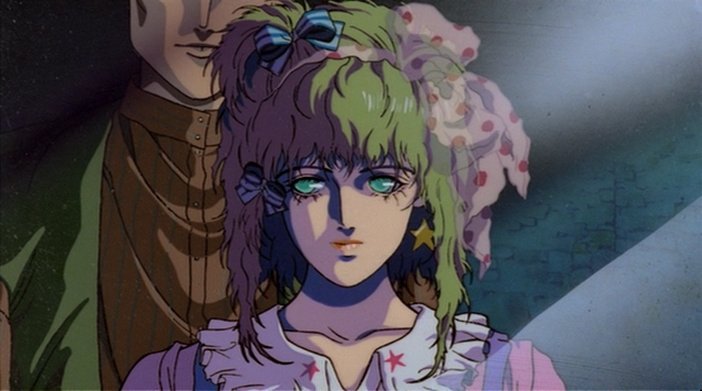 |
| From https://pbs.twimg.com/media/DRnpZRYUMAAoiys.jpg |
Presence
Director and Scenario: Yasuomi
Umetsu
Voice Cast: Kohji Moritsugu as
the Protagonist; Junko Terada as the Girl; Keiko Hanagata as the Granny; Kumiko
Takizawa as the Daughter / Small Mecha
One of the two segments with
dialogue, Umetsu takes a potentially
offensive idea of a male inventor, in a steampunk future with a mix of
industrial revolution aesthetic with eighties sci-fi, who decides to build a
female robot as his idealised woman. It's a risky theme to tackle, as he is
deliberately creating a woman in vast contrast to his career orientated wife,
but thankfully even when it leads to the ending, where he disappears into his
fantasy (or an actual escape into happiness) as an old man, it's done with
immense psychological complexity, deliberately drawn out and slow burn. He is,
visually, depicted as childish with his collection of mechanical toys, becoming
disturbed when his robot woman starts to exhibit emotions, and the segment does
run with the material carefully as a result.
Yasuomi Umetsu is sadly someone viewed in the notoriety of his
work. He has pornographic animation in his career, but the really controversial
work (and the one he is still known the most for) is Kite (1998), which is arguably notorious for problematic sexual
content involving its lead female character. Material which has had the film
banned in some countries. Enough for a director's cut to exist, his preferred
version, which is actually shorter as it excises this problematic material. Which
nonetheless, in whatever version was available, became a sizable hit in
American anime culture with a bit of popular recognition, enough that out of
all possible anime, it's one of the few to have a live action adaptation
starring Samuel L. Jackson.
What Presence, as my first Umetsu
anime, also shows however is that, if he wasn't known for Kite and other titles, he'd be known as an incredible character designer and animator,
an insane perfectionist who might've been a nightmare for some to work with
but, when the results are like his segment in Robot Carnival, leads to him making one of the best segments just
for how incredibly well made it is even among an anthology with exceptional
animation and production quality. The look of the segment, including a little
world building in its steampunk robot world. The moment of humour that cuts
between its serious drama, with a robotic man getting his head stolen by kids.
The intricate and realistic character designs especially of the robot girl
which would have taken days if not
more to perfect, Umetsu's style here
that are someone who jars against tight work schedules but with wonderful
results. An insane level of detail and character movement which is incredible.
As a result, alongside with how well it deals with a tricky subject matter, Presence is my favourite of the Robot Carnival shorts, making Umetsu's reputation for troubling porn
and transgressive material tragic when he could've spent his career more on
material like this.
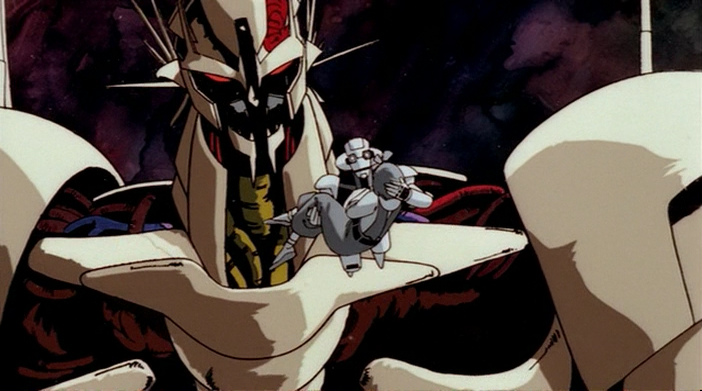 |
| From https://images3.imgbox.com/6c/58/aalH1ieW_o.png |
Starlight Angel
Director and Scenario: Hiroyuki
Kitazume
After the severity of Umetsu's segment, the other contender
for the most eighties of the segments appears, not a surprise as, known more as
an animator/manga author/character designer, Hiroyuki Kitazume made his reputation in the eighties especially
through the Gundam franchise. The
tale of a young woman who, at a robot themed theme park, has her heart broken
only for a mechanical employee to try to return her lost necklace back, it's a
simple tale told entirely in visuals, again the music video style of other
segments found including a virtual reality ride that is drastically effected by
her emotional state. Starlight is as well made, regardless of its visible time
stamping to the eighties, and is helped to stand out by its optimistic and
cheery tone, infectious in the right frame of mind. If anything Joe Hisaishi's
synthesizers here border the line between sweet and ridiculous the most,
managing to find the right balance that it's the former instead of the later.
 |
| From https://images3.imgbox.com/a5/44/aavvY5fZ_o.png |
Cloud
Director and Scenario: Manabu
Ōhashi (as Mao Lamdo)
All the segments, barring one,
are very accessible. Cloud is the
sole exception which is an experimental animated piece. Its creator Manabu Ōhashi began all the way back in the early sixties, on the likes of Astro Boy, and continued for at least
over fifty years in the industry, the kind of figure unfairly maligned (even by
the likes of myself) because he is more known for working on such work not as
the director or creator but someone who first started as an inbetweener and
went from there.
Cloud is not necessarily going to be a favourite for many, but I'm
the kind of fan of unconventional filmmaking who loved this segment, my second
favourite of the anthology. Cloud is
tentatively a retelling of the Pinocchio
story only with the entirety of the short being a robot boy walking past tableaus
of elaborate, gorgeously penned scratchboard drawings of clouds, mushroom
clouds of war and diving figures of the wind, one who turns him into a real boy
at the ending. It is a literal experiment, in its music and in its unconventional
look, of moving backgrounds as the boy is mainly walking to the left of the
screen, fragmenting of the panels for dynamic close-ups used occasionally. Cloud is utterly indulgent but a
beautiful, worthy inclusion. Considering the man behind it as well, its also a
testament to Robot Carnival that it
let many individuals not known as directors helm a piece entirely of their own
tests, something that has to be praised when, problematically, the anime
industry can be difficult in letting people helm their own projects or letting
new talent develop.
 |
From https://camstheothersideofanimation.files.
wordpress.com/2015/12/robot08.jpg?w=700 |
Strange Tales of Meiji Machine Culture: Westerner's Invasion
Director and Scenario: Hiroyuki
Kitakubo
Voice Cast: Kei Tomiyama as
Sankichi; Chisa Yokoyama as Yayoi; Katsue Miwa as Fukusuke; Kaneto Shiozawa as
Denjirō;Toku Nishio as Daimaru; James R. Bowers as John Jack Vorkarson III
Robot Carnival, having a significantly better sense of tonal
shifting than most anthologies, wisely followed the sedate, experimental
Cloud with a farce.
Hiroyuki Kitakubo is a fascinating
figure as his directorial filmography has big and very well regarded titles within
it -
Black Magic M-66 (1987),
Roujin Z (1991), the original 1993
animated adaptation
of Jojo's Bizarre
Adventure,
Golden Boy (1995) -
but being incredible small, finishing with his most well known project,
Blood: The Last Vampire (2000) [reviewed
HERE], only to never sit
in the directorial seat again past the year 2000. A shame as, able to juggle
the clever and unconventional satire of
Roujin
Z to giving a technical experiment like
Blood: The Last Vampire enough character to warrant a franchise, he
is a great example of a working anime director just from those examples of
drastically different genres and tones.
Strange
Tales of Meiji... is my third favourite entry of
Robot Carnival. It's the most distinct, set in Meiji era Japan with
the robots powered by steam and being built from wood and brick, itself a
unique take on the material as, depicting adolescents hijacking their town's
festival robot to take on an American one, it feels like it predates the tropes
of anime that would grow in the nineties onwards, and could've sustained a
longer work unlike the other segments.
The sense of being ahead of its
time is found in the main cast, anticipating the next decade with its
headstrong lead who is both noble but an idiot, the potential female love
interest who slaps him about in a love-hate relationship and various miscreants
in their fold who are try to defend their town in a ramshackle way, destroying
as much as the invader does. The unconventionality of these robots also brings
a curious spin on the mecha genre that could've been rewarding to see, as even
simple things found in futuristic giant robot stories are more complicated,
having to negotiate a time where firepower consists of a cannon that has to be
aimed perfectly and a firework launcher. It's a comedy which is energetic and
is also meant to parody its own characters' rah-rah, patriotic enthusiasm, not
only in the leads destroying buildings in their mistakes but the American
invading them, despite being voiced by an actor who speaks English as a first
language, giving his dialogue the appropriately wooden, borderline
incomprehensible "Engrish" quality for added amusement. (Controversially,
hindsight that this was done decades ago in the era of anime on video, Streamline Pictures in the US decided,
to contrast this, by giving the Japanese characters exaggerated
"Oriental" accents). Altogether, when the rest of the anthology is
not outright comedy in the slightest, this is a nice contrast to the rest which
succeeds.
 |
| From https://www.ganriki.org/media/2014/robot-carnival-162.jpg |
Chicken Man and Red Neck
Director and Scenario: Takashi
Nakamura
Takashi Nakamura, who would go on to direct an underrated (and
sadly maligned) animated feature called A
Tree of Palme (2002), closes Robot
Carnival, barring Otomo's closing
credits animation, with this nightmarish tale of robot invasion, absorbing all
machinery into a horrifying mass with a city, and the gangly man on a scooter
who gets in their way. Chicken Man...
is an excuse for elaborate production design, creations from ordinary objects
distorted and with the time and budget available to elaborate on them into incredibly
strange and imaginative scenes, mainly set up as an extended chase with a
peculiar, almost Rube Goldberg levels of pointlessness and exaggeration
throughout. It's a nice end to an incredible underrated production which I have
waited years to see, one that lived up to my expectations. Even without the
growing fondness for anthologies, Robot
Carnival is an applaudable production which deserves more recognition. It
is, also, a very good way to introduce people into anime, able to be separated
into bit sized segments or watched all at once, the tonal and genre shifts a
great advantage to it as, even if you hated or didn't like any of the segments,
they are short enough to not be a nuisance and followed by others which vary in
tones and style. Like the best of what anthologies should produce, it's a feast
for the eyes and creativity.










